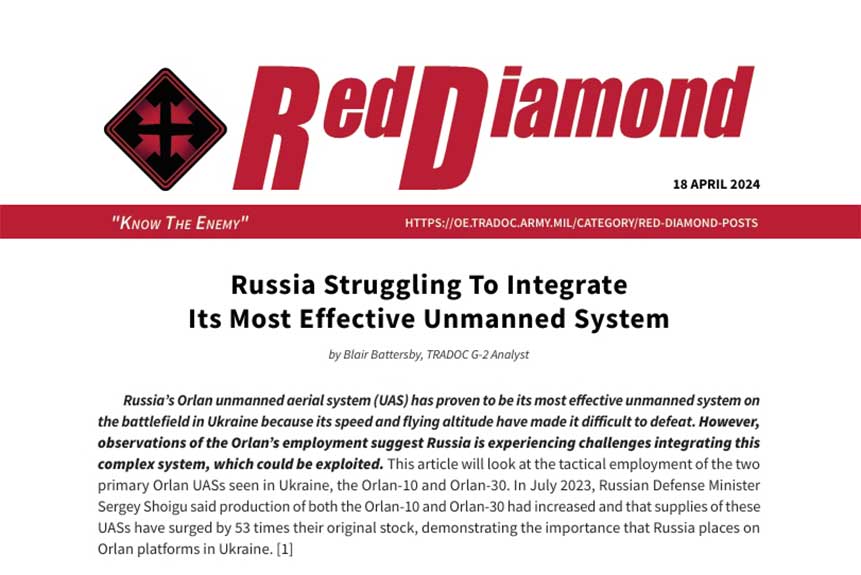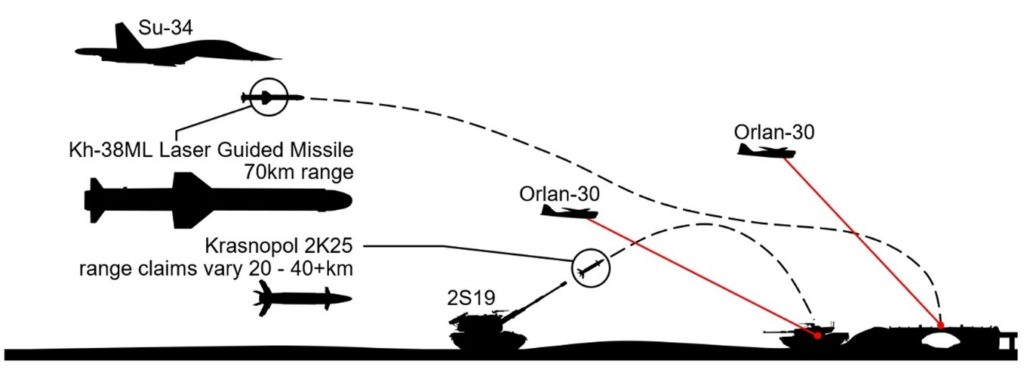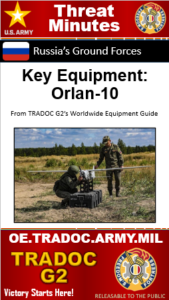
Russia Struggling To Integrate Its Most Effective Unmanned System
by Blair Battersby, TRADOC G-2 Analyst
by Blair Battersby, TRADOC G-2 Analyst

Vol. 15, No.2 Spring 2024
Russia’s Orlan unmanned aerial system (UAS) has proven to be its most effective unmanned system on the battlefield in Ukraine because its speed and flying altitude have made it difficult to defeat. However, observations of the Orlan’s employment suggest Russia is experiencing challenges integrating this complex system, which could be exploited. This article will look at the tactical employment of the two primary Orlan UASs seen in Ukraine, the Orlan-10 and Orlan-30. In July 2023, Russian Defense Minister Sergey Shoigu said production of both the Orlan-10 and Orlan-30 had increased and that supplies of these UASs have surged by 53 times their original stock, demonstrating the importance that Russia places on Orlan platforms in Ukraine. [1]
Capabilities of the Orlan System
The Orlan-10, a medium-range multipurpose UAS, supports Russian ground forces’ reconnaissance missions, electronic warfare (EW), and target acquisition. With its modular design, operators of the Orlan-10 can swap payloads to support multiple mission types. For Russian ground forces, the Orlan is deployed from a brigade’s UAS company, which typically has up to 18 Orlan vehicles, and is launched by catapult and recovered by an onboard parachute. Russia’s MP32M1 command-and-control vehicle can control four drones simultaneously. Forward drones conduct reconnaissance and jamming, while a drone to the rear often acts as a transponder, increasing the range and resilience of EW (see Figure 1). The Orlan-10 uses optical, infrared, and electromagnetic sensors to identify targets, and they emulate cell phone towers to selectively jam and interfere with civilian cellular telephones. Sensor data from the onboard payloads is transmitted in real-time via datalink, which also controls the UAS. Pre-programmed waypoints can also be set. [2]

Figure 1: Orlan-10, Orlan-30, and MP32M1 command-and-control vehicle.
The Orlan-10’s primary use in Ukraine is in support of Russia’s reconnaissance complex, locating Ukrainian troops for targeting by Russian artillery forces and increasing the lethality of Russian fires. The Orlan-10 enables Russian artillery to deliver accurate fires within as little as three minutes of identifying a Ukrainian position. Without the Orlan-10, Ukrainian sources indicate that Russian artillery can take up to 20 minutes to reach Ukrainian troops. [3]
Russia’s more advanced Orlan system, the Orlan-30, also plays a critical role in Ukraine, particularly for reconnaissance and target designation. The Orlan-30 can carry multiple payloads, including laser target designators [4], and is faster and can fly longer than the Orlan-10. The Orlan-30 also has a maximum take-off weight of 27kg compared to the Orlan-10’s 16.5kg. [2]
The Orlan-30 can improve the accuracy of Russian artillery by designating targets for laser-guided munitions, such as Krasnopol shells. These laser-guided artillery rounds are stabilized by fins and base-bleed assisted. Krasnopol rounds can be fired from common 152mm frontline platforms like the 2S19 self-propelled howitzer (see Figure 2). Upgraded versions are claimed to be 95-percent accurate at 43km [5]; however, these munitions have previously struggled to ‘see’ the designated target through cloud cover, preventing them from acquiring targets quickly enough to adjust their trajectory accurately. [6] Ground-based laser designators used to guide Krasnopol are heavy, meaning the Orlan-30’s greater payload capacity compared to the Orlan-10’s dictates its usage. Independent commentators state that Russia expended most of its Krasnopol stock during its initial 2022 invasion of Ukraine, using them as indiscriminate, unguided area munitions. [7] In November 2023, Russia reportedly had increased production of 152mm Krasnopol shells.
Russia has also used the Orlan-30 to designate targets for air-launched guided missiles, indicating possible joint force integration. In September 2023, Russia destroyed bridges in Kharkiv using Kh-38ML guided missiles fired from Su-34 aircraft. The missiles were guided by laser target designators on board Orlan-30s (see Figure 2). [8] Control of the Orlan-30s by Ground Forces would indicate effective joint force integration, although it is unclear whether the Russian Aerospace Force provided and controlled both the Orlan UASs and the means of delivery.

Figure 2: Orlan-30 providing laser targeting for air-launched missiles and Krasnopol artillery (not to scale).
While the Orlan-30 has recently been used to designate targets for laser-guided munitions, more commonly, the overall complex is used for EW and visual identification of targets for regular artillery and one-way attack drones. Russian forces typically receive targets based on aircraft telemetry data or proximity to known ground features. Target positions are then passed to conventional cannon and rocket artillery and operators of one-way attack drones like the Lancet-3 and Iranian-made Shahed-136. [2]
Challenges Employing the Orlan System
The Orlan’s employment in Ukraine comes with challenges because its many capabilities must be integrated into a ‘system’ (cистема) or a group of complexes. Its success depends not only on the availability and reliability of its components but also on components and interfaces with external, dependent systems.
The full potential of the Orlan system is limited by Russia’s struggles with integration, transfer of target data, and poorly trained personnel. Passage of target data is supposed to be enabled by Strelets, a network of ruggedized tablet computers that allows users to plot and view targets on a shared digital map. As of May 2023, Strelets was not widely used in Ukraine due to lack of availability, misconfiguration, and inadequate operator training. [9] Russian drone operators have no direct means to rapidly share live observations with fire control centers. [10,11]
The Orlan’s developer, Russia’s Special Technology Centre (STC), is constrained by international sanctions because it relies on components from foreign manufacturers. Using intermediaries and front companies, STC has used Western manufacturers to supply integrated circuits that govern specific functions like satellite navigation, flight sensors, and data transmission. Since February 2022, STC has also increased its reliance on suppliers based in Hong Kong and China [3].
Severe sustainment challenges limit the Russian military’s ability to refit the Orlan complex with original equipment manufacturer parts, relying instead on innovative use of unrelated commercial components to mitigate this challenge. Videos on YouTube show crashed aircraft fitted with consumer cameras and plastic drink-bottle fuel tanks. [12] Although these videos highlight sustainment challenges, using affordable, readily available components means multiple units can be built for the cost of a single, sophisticated platform.

Figure 3: Stills from a YouTube video showing a crashed Orlan-10.
Implications for the U.S. Army
Russia’s adaptations to optimize the Orlan system for use in the Ukraine war suggest ways in which the U.S. Army can train for future conflicts. Indicators of future adaptations, such as the procurement of targeting components, can be external to the sensor-shooter loop and are likely to be observable before their deployment on the battlefield.
- Training would be improved if it went beyond merely identifying an enemy platform since this does not necessarily imply its purpose or mission. The opposing forces we train against should be adaptive and innovative in using UAS, taking lessons from Russia’s difficulties in Ukraine. Conversely, weaknesses in the integration of complex enemy systems could be an exploitable vulnerability.
- Laser target designation could be simulated using existing training equipment, helping to refine laser contact procedures. Actions might evolve to include reproducing deceptive laser spots or backtracking detected beams to engage emitters.
- Trainers could update curriculum to prepare Soldiers for scenarios in which drones assist drones. Russia’s one-way attack drones, including the Lancet-3 and Shahed-136, are fitted with the means to receive live target data and could receive it from other UASs. Larger platforms like the Orlan-50 might take on the role of mothership for smaller sensors, emitters, and munitions.
REFERENCES
[1] “Orlan Drone Supplies Skyrocketing – Russian Defense Minister”, TASS, (July 11, 2023), hxxps://tass.com/defense/1645501
[2] Worldwide Equipment Guide, TRADOC G-2, https://odin.tradoc.army.mil/WEG/
[3] James Byrne, Dr Jack Watling , Professor Justin Bronk, Gary Somerville, Joe Byrne, Jack Crawford and Jane Baker “Tracking the Supply Chains of Russia’s Most Successful UAV”, RUSI (December 15, 2022), hxxps://static.rusi.org/SR-Orlan-complex-web-final.pdf
[4] “Russia Starts Promoting Orlan Drone with Laser Target Designation System”, TASS, (August 17, 2023), hxxps://tass.com/defense/1661863
[5] David Hambling, “Russia’s Deadly Artillery Drones Have A Strange Secret (Updated)”, Forbes, (April 11, 2022), hxxps://www.forbes.com/sites/davidhambling/2022/04/11/russias-deadly-artillery-drones-have-a-strange-secret/?sh=25a3101a779d
[6] “Update on Ukraine”, British Defence Intelligence, (November 14, 2023), hxxps://twitter.com/DefenceHQ/status/1724334648942059695?s=20
[7] “Krasnopol 152mm Guided Artillery Shell” Military Today, hxxps://www.militarytoday.com/artillery/krasnopol.htm
[8] Boyko Nikolov, “Russia uses Orlan UAV to target Kh-38ML missile fired from a Su-34”, (September 30, 2023), hxxps://bulgarianmilitary.com/2023/09/30/russia-uses-orlan-uav-to-target-kh-38ml-missile-fired-from-a-su-34/
[9] Dr Jack Watling and Nick Reynolds, “Meatgrinder: Russian Tactics in the Second Year of its Invasion of Ukraine”, RUSI (May 19, 2023), hxxps://static.rusi.org/403-SR-Russian-Tactics-web-final.pdf
[10] “Orlan-10 Russian Drone in Action”, YouTube, (October 3, 2021), hxxps://www.youtube.com/watch?v=8mWVmQ5JBc4
[11] Lester Grau and Charles Bartles “The Russian Reconnaissance Fire Complex Comes of Age”, FMSO, (May 2018), hxxps://www.ccw.ox.ac.uk/blog/2018/5/30/the-russian-reconnaissance-fire-complex-comes-of-age
[12] “Disassembly of crashed Orlan-10”, YouTube (April 10, 2022), hxxps://www.youtube.com/watch?v=WP681BVWk0Q
Illustrations by the author
DISTRIBUTION A: APPROVED FOR PUBLIC RELEASE; DISTRIBUTION IS UNLIMITED
Distribution A: Approved for public release
Categories:
Tags:
Russia Struggling To Integrate Its Most Effective Unmanned System
by Blair Battersby, TRADOC G-2 Analyst
File Size:
682KB
File Type:
Page Count:
5


